高考英语作文100个中国传统文化名词中英对照
- 格式:docx
- 大小:791.43 KB
- 文档页数:2
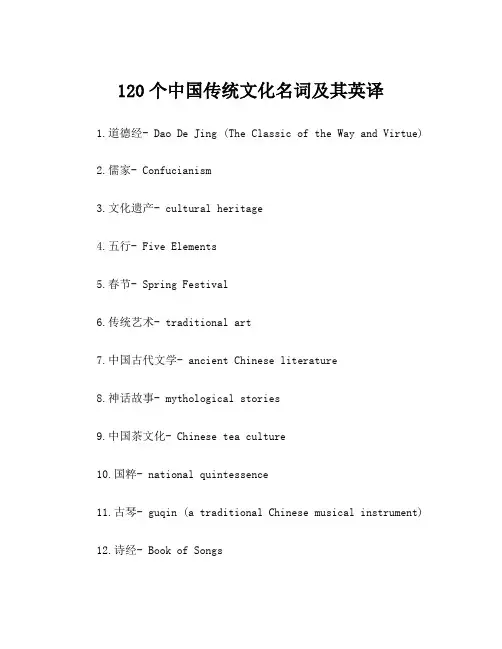
120个中国传统文化名词及其英译1.道德经- Dao De Jing (The Classic of the Way and Virtue)2.儒家- Confucianism3.文化遗产- cultural heritage4.五行- Five Elements5.春节- Spring Festival6.传统艺术- traditional art7.中国古代文学- ancient Chinese literature8.神话故事- mythological stories9.中国茶文化- Chinese tea culture10.国粹- national quintessence11.古琴- guqin (a traditional Chinese musical instrument)12.诗经- Book of Songs13.行书- running script (a style of Chinese calligraphy)14.红楼梦- Dream of the Red Chamber15.京剧- Beijing Opera16.四书五经- Four Books and Five Classics (Confucian classical texts)17.中医- Traditional Chinese Medicine (TCM)18.书法- calligraphy19.文房四宝- Four Treasures of the Study (brush, ink stick, inkstone, and paper)20.传统节日- traditional festivals21.工艺品- handicrafts22.长城- Great Wall23.农历- lunar calendar24.中国画- Chinese painting25.合作共赢- win-win cooperation26.四合院- quadrangle courtyard27.曲艺- Chinese folk art28.灯笼- lantern29.传统婚礼- traditional wedding ceremony30.拜年- pay a New Year visitAdditional Extension:31.古人- ancient people32.传统建筑- traditional architecture33.传统音乐- traditional music34.陶瓷艺术- ceramic art35.传统戏剧- traditional drama36.中国历史- Chinese history37.长街短巷- long streets and alleys38.风水- Feng Shui39.传统服饰- traditional costumes40.中国象棋- Chinese chess41.中国民歌- Chinese folk songs42.传统美食- traditional cuisine43.传统医学- traditional medicine44.传统童谣- traditional nursery rhymes45.传统工艺- traditional craftsmanship46.传统家具- traditional furniture47.传统舞蹈- traditional dance48.传统庙宇- traditional temples49.传统阳历- traditional solar calendar50.中国春联- Chinese New Year couplets。
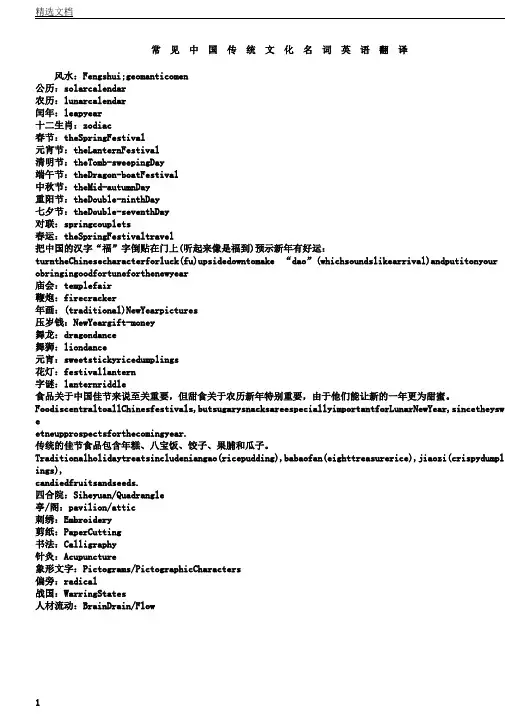
常见中国传统文化名词英语翻译风水:Fengshui;geomanticomen公历:solarcalendar农历:lunarcalendar闰年:leapyear十二生肖:zodiac春节:theSpringFestival元宵节:theLanternFestival清明节:theTomb-sweepingDay端午节:theDragon-boatFestival中秋节:theMid-autumnDay重阳节:theDouble-ninthDay七夕节:theDouble-seventhDay对联:springcouplets春运:theSpringFestivaltravel把中国的汉字“福”字倒贴在门上(听起来像是福到)预示新年有好运:turntheChinesecharacterforluck(fu)upsidedowntomake “dao”(whichsoundslikearrival)andputitonyour obringingoodfortuneforthenewyear庙会:templefair鞭炮:firecracker年画:(traditional)NewYearpictures压岁钱:NewYeargift-money舞龙:dragondance舞狮:liondance元宵:sweetstickyricedumplings花灯:festivallantern字谜:lanternriddle食品关于中国佳节来说至关重要,但甜食关于农历新年特别重要,由于他们能让新的一年更为甜蜜。
FoodiscentraltoallChinesfestivals,butsugarysnacksareespeciallyimportantforLunarNewYear,sincetheysw eetneupprospectsforthecomingyear.传统的佳节食品包含年糕、八宝饭、饺子、果脯和瓜子。
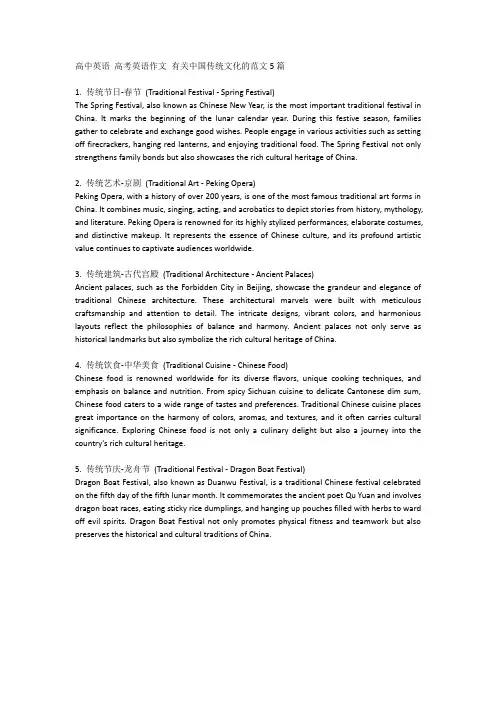
高中英语高考英语作文有关中国传统文化的范文5篇1. 传统节日-春节(Traditional Festival - Spring Festival)The Spring Festival, also known as Chinese New Year, is the most important traditional festival in China. It marks the beginning of the lunar calendar year. During this festive season, families gather to celebrate and exchange good wishes. People engage in various activities such as setting off firecrackers, hanging red lanterns, and enjoying traditional food. The Spring Festival not only strengthens family bonds but also showcases the rich cultural heritage of China.2. 传统艺术-京剧(Traditional Art - Peking Opera)Peking Opera, with a history of over 200 years, is one of the most famous traditional art forms in China. It combines music, singing, acting, and acrobatics to depict stories from history, mythology, and literature. Peking Opera is renowned for its highly stylized performances, elaborate costumes, and distinctive makeup. It represents the essence of Chinese culture, and its profound artistic value continues to captivate audiences worldwide.3. 传统建筑-古代宫殿(Traditional Architecture - Ancient Palaces)Ancient palaces, such as the Forbidden City in Beijing, showcase the grandeur and elegance of traditional Chinese architecture. These architectural marvels were built with meticulous craftsmanship and attention to detail. The intricate designs, vibrant colors, and harmonious layouts reflect the philosophies of balance and harmony. Ancient palaces not only serve as historical landmarks but also symbolize the rich cultural heritage of China.4. 传统饮食-中华美食(Traditional Cuisine - Chinese Food)Chinese food is renowned worldwide for its diverse flavors, unique cooking techniques, and emphasis on balance and nutrition. From spicy Sichuan cuisine to delicate Cantonese dim sum, Chinese food caters to a wide range of tastes and preferences. Traditional Chinese cuisine places great importance on the harmony of colors, aromas, and textures, and it often carries cultural significance. Exploring Chinese food is not only a culinary delight but also a journey into the country's rich cultural heritage.5. 传统节庆-龙舟节(Traditional Festival - Dragon Boat Festival)Dragon Boat Festival, also known as Duanwu Festival, is a traditional Chinese festival celebrated on the fifth day of the fifth lunar month. It commemorates the ancient poet Qu Yuan and involves dragon boat races, eating sticky rice dumplings, and hanging up pouches filled with herbs to ward off evil spirits. Dragon Boat Festival not only promotes physical fitness and teamwork but also preserves the historical and cultural traditions of China.。
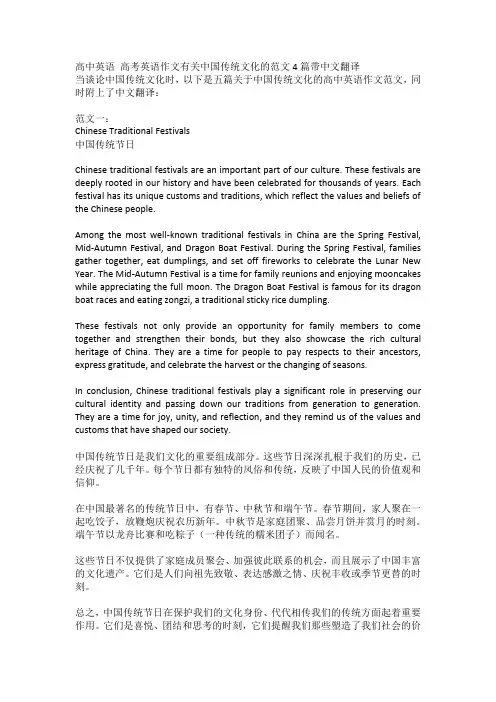
高中英语高考英语作文有关中国传统文化的范文4篇带中文翻译当谈论中国传统文化时,以下是五篇关于中国传统文化的高中英语作文范文,同时附上了中文翻译:范文一:Chinese Traditional Festivals中国传统节日Chinese traditional festivals are an important part of our culture. These festivals are deeply rooted in our history and have been celebrated for thousands of years. Each festival has its unique customs and traditions, which reflect the values and beliefs of the Chinese people.Among the most well-known traditional festivals in China are the Spring Festival, Mid-Autumn Festival, and Dragon Boat Festival. During the Spring Festival, families gather together, eat dumplings, and set off fireworks to celebrate the Lunar New Year. The Mid-Autumn Festival is a time for family reunions and enjoying mooncakes while appreciating the full moon. The Dragon Boat Festival is famous for its dragon boat races and eating zongzi, a traditional sticky rice dumpling.These festivals not only provide an opportunity for family members to come together and strengthen their bonds, but they also showcase the rich cultural heritage of China. They are a time for people to pay respects to their ancestors, express gratitude, and celebrate the harvest or the changing of seasons.In conclusion, Chinese traditional festivals play a significant role in preserving our cultural identity and passing down our traditions from generation to generation. They are a time for joy, unity, and reflection, and they remind us of the values and customs that have shaped our society.中国传统节日是我们文化的重要组成部分。
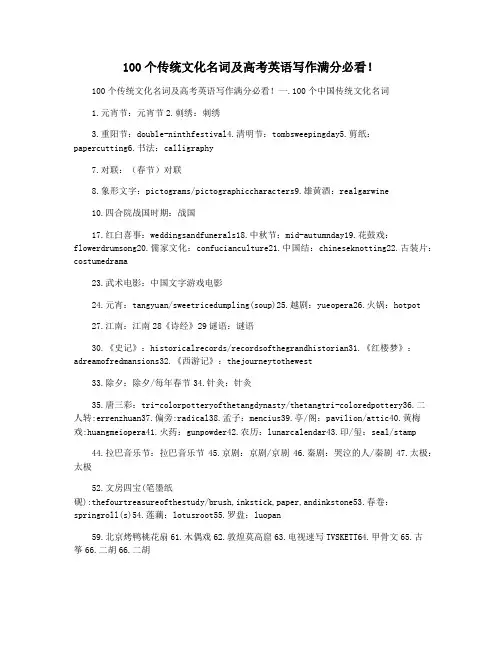
100个传统文化名词及高考英语写作满分必看!100个传统文化名词及高考英语写作满分必看!一.100个中国传统文化名词1.元宵节:元宵节2.刺绣:刺绣3.重阳节:double-ninthfestival4.清明节:tombsweepingday5.剪纸:papercutting6.书法:calligraphy7.对联:(春节)对联8.象形文字:pictograms/pictographiccharacters9.雄黄酒:realgarwine10.四合院战国时期:战国17.红臼喜事:weddingsandfunerals18.中秋节:mid-autumnday19.花鼓戏:flowerdrumsong20.儒家文化:confucianculture21.中国结:chineseknotting22.古装片:costumedrama23.武术电影:中国文字游戏电影24.元宵:tangyuan/sweetricedumpling(soup)25.越剧:yueopera26.火锅:hotpot27.江南:江南28《诗经》29谜语:谜语30.《史记》:historicalrecords/recordsofthegrandhistorian31.《红楼梦》:adreamofredmansions32.《西游记》:thejourneytothewest33.除夕:除夕/每年春节34.针灸:针灸35.唐三彩:tri-colorpotteryofthetangdynasty/thetangtri-coloredpottery36.二人转:errenzhuan37.偏旁:radical38.孟子:mencius39.亭/阁:pavilion/attic40.黄梅戏:huangmeiopera41.火药:gunpowder42.农历:lunarcalendar43.印/玺:seal/stamp44.拉巴音乐节:拉巴音乐节45.京剧:京剧/京剧46.秦剧:哭泣的人/秦剧47.太极:太极52.文房四宝(笔墨纸砚):thefourtreasureofthestudy/brush,inkstick,paper,andinkstone53.春卷:springroll(s)54.莲藕:lotusroot55.罗盘:luopan59.北京烤鸭桃花扇61.木偶戏62.敦煌莫高窟63.电视速写TVSKETT64.甲骨文65.古筝66.二胡66.二胡67.门当户对:perfectmatch/exactmatch68.《水浒》:watermargin/outlawsofthemarsh69.除夕:农历除夕70皇家书院74.泼水节:water-splashingday75.馄饨:wonton76.蒸扭卷77.羊肉泡馍:pitabreadsoakedinlambsoup78.冰糖葫芦:一小片糖葫芦(orapples等)79.八宝饭:八宝饭布丁80.无玻璃:81.粉丝豆腐冻82.素描:诙谐小品83.孝顺:toshowfilialobedience84.武术:wushu(chinesemartialarts)85.宣纸:ricepaper86.衙门:yamen。

Part1:1.中国龙对龙图腾的崇拜在中国大约已绵延了八千多年。
中国龙是古人将鱼、蛇、马、牛等动物与云雾、雷电等自然天象集合而成的一种神物。
中国龙的形成与中华民族的多元融合过程同步。
在中国人的心目中,龙具有振奋腾飞、开拓变化的寓意和团结凝聚的精神。
Chinese DragonDragon totem worship in China has been aroundfor the last 8,000 year. The ancients in China considered the dragon (or long)a fetish that combines animals including the fish, snake, horse and ox withcloud, thunder, lightning and other natural celestial phenomena. The Chinesedragon was formed in accordance with the multicultural fusion process of theChinese nation. To the Chinese, the dragon signifies innovation and cohesion.2.饺子饺子是深受中国人民喜爱的传统特色食品。
相处为古代医圣张仲景发明。
饺子的制作是包括:1)擀皮、2)备馅、3)包馅水煮三个步骤。
其特点是皮薄馅嫩,味道鲜美,形状独特,百食不厌。
民间有“好吃不过饺子”的俗语。
中国人接亲待友、逢年过节都有包饺子吃的习俗,寓意吉利。
对崇尚亲情的中国人来讲,“更岁饺子”吃饺子,更是欢度除夕、辞旧迎新必不可少的内容。
DumplingsDumplings are one of the Chinese people’s favorite traditional dishes. Accordingto an ancient Chinese legend, dumplings were first made by the medical saint-Zhang Zhong jing. There are three steps involved in making dumplings: 1) make dumplingwrappers out of dumpling flour; 2) prepare the dumpling stuffing; 3) makedumplings and boil them. With thin and elastic dough skin, fresh and tenderstuffing, delicious taste, and unique shapes, dumplings are worth eatinghundreds of times. There’san old saying that claims, “Nothing could be more delicious than dumplings.”During the Spring Festival and otherholidays, or when treating relatives and friends, Chinese people like to followthe auspicious custom of eating dumplings. To Chinese people who show highreverence for family love, having dumplings at the moment the old year isreplaced by the new is an essential part of bidding farewell to the old andushering in the new year.3.针灸针灸是中医学的重要组成部分。

100个中国传统文化词汇的英文翻译翻译元宵节元宵节 Lantern Fes val 刺绣刺绣Embroidery 重阳节重阳节Double-Ninth Fes val 清明节清明节Tomb sweeping day 剪纸剪纸Paper Cu ng 书 法Calligraphy 对联对联 (Spring Fes val) Couplets 象形文字 Pictograms/Pictographic Characters雄黄酒雄黄酒Realgar wine 四合院四合院Siheyuan/Quadrangle 战国战国Warring States 风水风水Fengshui/Geoman c Omen 昆曲昆曲Kunqu Opera 长 城 The Great Wall 集体舞集体舞Group Dance 黄土高原黄土高原Loess Plateau 红臼喜事红臼喜事 Weddings and Funerals中秋节中秋节Mid-Autumn Day 花鼓戏花鼓戏Flower Drum Song 儒家文化儒家文化Confucian Culture 中国结中国结Chinese kno ng 古装片古装片Costume Drama 武打片武打片 Chinese Swordplay Movie元宵元宵 Tangyuan/Sweet Rice Dumpling 越剧越剧 Yue Opera 火锅火锅Hot Pot 江南江南 South Regions of the Yangtze River 谜语谜语Riddle 《诗经》《诗经》 The Book of Songs 《史记》《史记》Historical Records/Records of the Grand Historian《红楼梦》《红楼梦》 A Dream of Red Mansions《西游记》《西游记》 The Journey to the West除夕除夕Chinese New Year’s Eve/Eve of the Spring Fes val 针灸针灸Acupuncture 唐三彩唐三彩 Tri-color Po ery of the TangDynasty/ The Tang Tri-colored po ery 孔子孔子 Confucius 偏旁偏旁 Radical 孟子孟子Mencius 亭/ 阁 Pavilion/ A c 黄梅戏黄梅戏Huangmei opera 火 药 Gunpowder 农历农历Lunar Calendar 印/ 玺 Seal/Stamp 腊 八 节 The laba Rice Porridge Fes val京 剧 Beijing Opera/Peking Opera秦腔秦腔Crying of Qin People/Qin Opera 太极拳太极拳TaiChi 《本草纲目》《本草纲目》 Compendium of Materia Medica天坛天坛Altar of Heaven in Beijing 小吃摊小吃摊Snack Bar/Snack Stand 红双喜红双喜Double Happiness 文房四宝(笔墨纸砚)笔墨纸砚) The Four Treasure of the Study (Brush,Inks ck,Paper,and Inkstone ) 春卷春卷Spring Roll(s) 莲藕莲藕Lotus Root 罗盘罗盘Luopan/ compass 故宫博物院故宫博物院The Palace Museum 相声相声Cross-talk/Comic Dialogue 五行五行Five Phases 北京烤鸭北京烤鸭Beijing Roast Duck 《桃花扇》《桃花扇》 The Peach Blossom Fan木偶戏木偶戏Puppet Show 敦煌莫高窟敦煌莫高窟Mogao Caves电视小品电视小品TV Sketch/TV Skit 甲骨文甲骨文Oracle Bone Inscrip ons 古筝古筝Chinese Zither 杂技杂技acroba cs 门当户对门当户对 Perfect Match/Exact Match《水浒》《水浒》 Water Margin/Outlaws of the Marsh除夕除夕Chinese New Year's Eve 国子监国子监Imperial Academy 兵马俑兵马俑 Co a Warriors/ Terraco a Army 旗袍旗袍Cheongsam 中国古代四大发明中国古代四大发明the four great inven ons of ancient China (火药gunpowder 印刷术prin ng 造纸术paper-making 指南针the compass ) 泼水节泼水节 Water-Splashing Day 馄饨馄饨Wonton 花卷花卷Steamed twisted rolls 羊肉泡馍羊肉泡馍Pita Bread Soaked in Lamb Soup冰糖葫芦冰糖葫芦 A s ck of sugar-coated haws (or apples,etc.) 八宝饭八宝饭 Eight-treasure rice pudding粉丝粉丝Glass Noodles 豆腐脑豆腐脑 Jellied bean curd 小品小品Wi y Skits 孝顺孝顺To show filial obedience 武术武术 Wushu(Chinese Mar al Arts)宣纸宣纸Rice Paper 陶器陶器po ery/earthenware 佛教佛教Buddhism 中庸中庸 The way of medium(Golden Means) 爆竹爆竹firecracker 东坡肉东坡肉Dongpo Pork 中山陵中山陵 The Sun Yat-sen Mausoleum秦淮河秦淮河Qinhuai River 玄武湖玄武湖Xuanwu Lake夫子庙夫子庙The Confucian Temple 鸭血粉丝鸭血粉丝Duck blood fans 盐水鸭盐水鸭 Yanshuiya, or salted and baked duck 大煮干丝大煮干丝Gansi 小笼包小笼包Steamed buns 明孝陵明孝陵Ming Tomb 云锦云锦 Nanjing brocade。
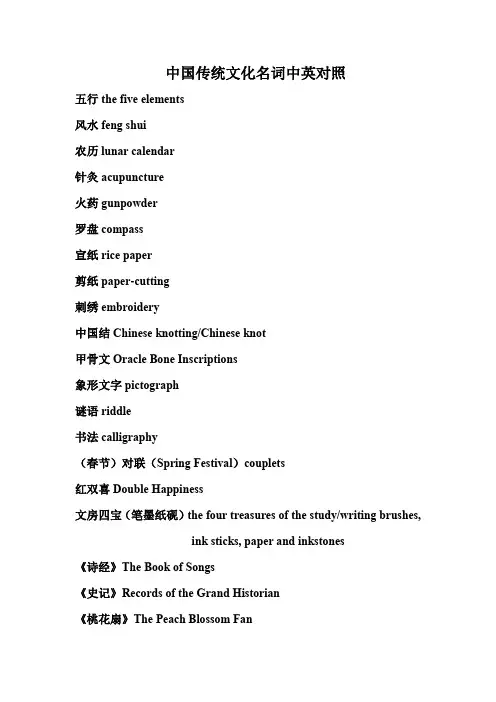
中国传统文化名词中英对照五行the five elements风水feng shui农历lunar calendar针灸acupuncture火药gunpowder罗盘compass宣纸rice paper剪纸paper-cutting刺绣embroidery中国结Chinese knotting/Chinese knot甲骨文Oracle Bone Inscriptions象形文字pictograph谜语riddle书法calligraphy(春节)对联(Spring Festival)couplets红双喜Double Happiness文房四宝(笔墨纸砚)the four treasures of the study/writing brushes,ink sticks, paper and inkstones《诗经》The Book of Songs《史记》Records of the Grand Historian《桃花扇》The Peach Blossom Fan《西游记》The Journey to the West《红楼梦》A Dream of Red Mansions《水浒传》Water Margin/Outlaws of the Marsh 《本草纲目》Compendium of Materia Medica 孟子Mencius孔子Confucius中庸the way of medium儒家文化Confucian Culture门当户对perfect match红白喜事weddings and funerals旗袍cheongsam相声cross-talk/comic dialogue小品sketch/skit二胡erhu古筝Chinese zither秦腔Crying of Qin People/Qin Opera昆曲Kunqu Opera京剧Beijing Opera/Peking Opera越剧Yue Opera木偶戏puppet show花鼓戏flower-drum opera黄梅戏Huangmei Opera胡同hutong四合院siheyuan/quadrangle亭/阁pavilion/attic天坛the Temple of Heaven in Beijing长城the Great Wall故宫博物院the Palace Museum除夕New Year’s Eve元宵节the Lantern Festival重阳节the Double Ninth Festival清明节Tomb-Sweeping Day中秋节Mid-Autumn Festival腊八节the Laba Festival泼水节the Water-Sprinkling Festival集体舞group dance太极拳Tai Chi古装片costume drama武打片Chinese swordplay movie中国武术Chinese kung fu唐三彩tri-colored glazed pottery of the Tang Dynasty 兵马俑the Terracotta Warriors/Terracotta Army战国Warring States江南south of the Y angtze River黄土高原loess plateau春卷spring roll(s)花卷steamed twisted roll小笼包steamed buns八宝饭eight-treasure rice pudding豆腐脑jellied bean curd馄饨wonton汤圆tangyuan/Glutinous Rice Balls粉丝glass noodles莲藕lotus root火锅hot pot雄黄酒realgar wine东坡肉Dongpo Pork北京烤鸭Beijing Roast Duck羊肉泡馍Pita Bread Soaked in Lamb Soup 冰糖葫芦sugar-coated haws小吃摊Snack Stand玺imperial seal/royal seal国子监Imperial Academy。
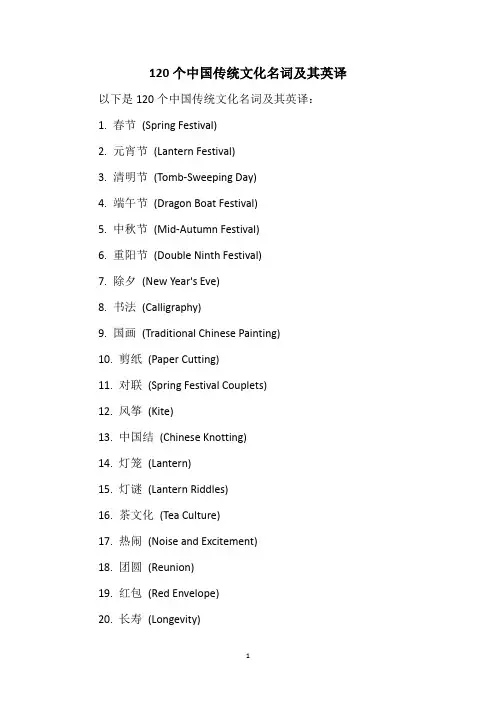
120个中国传统文化名词及其英译以下是120个中国传统文化名词及其英译:1. 春节(Spring Festival)2. 元宵节(Lantern Festival)3. 清明节(Tomb-Sweeping Day)4. 端午节(Dragon Boat Festival)5. 中秋节(Mid-Autumn Festival)6. 重阳节(Double Ninth Festival)7. 除夕(New Year's Eve)8. 书法(Calligraphy)9. 国画(Traditional Chinese Painting)10. 剪纸(Paper Cutting)11. 对联(Spring Festival Couplets)12. 风筝(Kite)13. 中国结(Chinese Knotting)14. 灯笼(Lantern)15. 灯谜(Lantern Riddles)16. 茶文化(Tea Culture)17. 热闹(Noise and Excitement)18. 团圆(Reunion)19. 红包(Red Envelope)20. 长寿(Longevity)21. 福字(Fu Character)22. 禅宗(Zen Buddhism)23. 道教(Taoism)24. 佛教(Buddhism)25. 儒家(Confucianism)26. 旗袍(Qipao)27. 长衫(Long Shirt)28. 唱戏(Opera)29. 京剧(Peking Opera)30. 象棋(Chinese Chess)31. 麻将(Mahjong)32. 瓜子(Sunflower Seeds)33. 腊八节(Laba Festival)34. 元宵(Tangyuan)35. 饺子(Dumplings)36. 年糕(Nian Gao)37. 火锅(Hot Pot)38. 炸酱面(Noodles with Soybean Paste)39. 午餐肉(Luncheon Meat)40. 豆腐(Tofu)41. 麻婆豆腐(Mapo Tofu)42. 宫保鸡丁(Kung Pao Chicken)43. 鱼香肉丝(Fish-Flavored Shredded Pork)44. 红烧肉(Braised Pork Belly)45. 糖葫芦(Candied Fruit on a Stick)46. 美食(Delicacy)47. 食文化(Food Culture)48. 酒文化(Wine Culture)49. 茅台酒(Maotai)50. 龙井茶(Longjing Tea)51. 碧螺春(Biluochun Tea)52. 普洱茶(Pu'er Tea)53. 茶道(Tea Ceremony)54. 茶艺(Tea Art)55. 书法(Calligraphy)56. 绘画(Painting)57. 雕塑(Sculpture)58. 陶艺(Pottery)59. 瓷器(Porcelain)60. 纺织(Textile)61. 刺绣(Embroidery)62. 缝纫(Sewing)63. 针灸(Acupuncture)64. 中药(Traditional Chinese Medicine)65. 草药(Herbal Medicine)66. 风水(Fengshui)67. 堪舆(Kanyu)68. 儒家经典(Confucian Classics)69. 四书五经(Four Books and Five Classics)70. 《大学》(The Great Learning)71. 《中庸》(The Doctrine of the Mean)72. 《论语》(The Analects of Confucius)73. 《孟子》(The Mencius)74. 《诗经》(The Book of Songs)75. 《尚书》(The Book of Documents)76. 《礼记》(The Book of Rites)77. 《易经》(The Book of Changes)78. 《春秋》(The Spring and Autumn Annals)79. 《孝经》(The Book of Filial Piety)80. 《尔雅》(The Book of Erya)81. 儒家思想(Confucian Thought)82. 道家思想(Taoist Thought)83. 佛教思想(Buddhist Thought)84. 法家思想(Legalist Thought)85. 墨家思想(Mohist Thought)86. 阴阳五行(Yin and Yang, Five Elements)87. 八卦(Eight Trigrams)88. 易经(I Ching)89. 太极(Tai Chi)90. 武术(Wushu)91. 少林寺(Shaolin Temple)92. 武当山(Wudang Mountains)93. 内功(Neigong)94. 外功(Waijong)95. 拳法(Boxing)96. 剑法(Swordplay)97. 气功(Qigong)98. 八段锦(Baduanjin)99. 五禽戏(Wuqinxi)100. 二十四节气(Twenty-Four Solar Terms)101. 农历(Lunar Calendar)102. 阳历(Solar Calendar)103. 天干地支(Heavenly Stems and Earthly Branches) 104. 黄道吉日(Good Fortune Days)105. 红事(Weddings)106. 白事(Funerals)107. 喜帖(Wedding Invitation)108. 聘礼(Betrothal Gift)109. 六礼(Six Ceremonies)110. 三书六礼(Three Books and Six Ceremonies)111. 红娘(Matchmaker)112. 月老(Old Man Under the Moon)113. 金榜题名(Golden List)114. 状元(Number One Scholar)115. 进士(Jinshi)116. 举人(Juren)117. 秀才(Xiucai)118. 科举(Imperial Examination)119. 四书(Four Books)120. 五经(Five Classics)这些名词涵盖了中国的传统文化、哲学思想、宗教信仰、节日庆典、文学艺术、饮食习惯、服饰风格、武术健身、天文历法等多个方面,反映了中国悠久的历史和丰富的文化内涵。
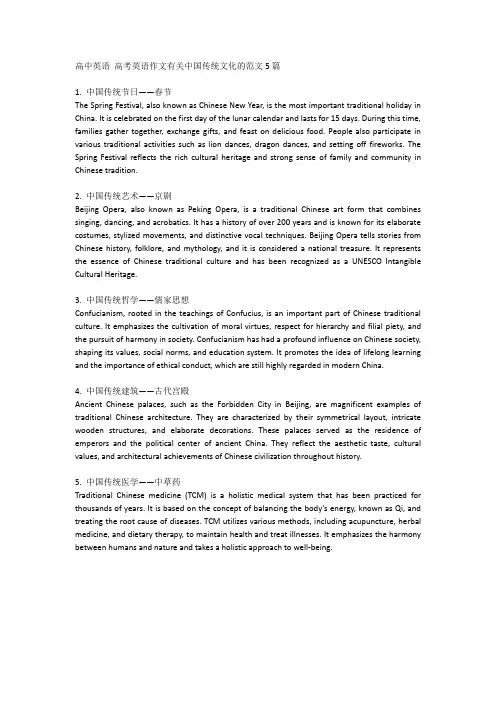
高中英语高考英语作文有关中国传统文化的范文5篇1. 中国传统节日——春节The Spring Festival, also known as Chinese New Year, is the most important traditional holiday in China. It is celebrated on the first day of the lunar calendar and lasts for 15 days. During this time, families gather together, exchange gifts, and feast on delicious food. People also participate in various traditional activities such as lion dances, dragon dances, and setting off fireworks. The Spring Festival reflects the rich cultural heritage and strong sense of family and community in Chinese tradition.2. 中国传统艺术——京剧Beijing Opera, also known as Peking Opera, is a traditional Chinese art form that combines singing, dancing, and acrobatics. It has a history of over 200 years and is known for its elaborate costumes, stylized movements, and distinctive vocal techniques. Beijing Opera tells stories from Chinese history, folklore, and mythology, and it is considered a national treasure. It represents the essence of Chinese traditional culture and has been recognized as a UNESCO Intangible Cultural Heritage.3. 中国传统哲学——儒家思想Confucianism, rooted in the teachings of Confucius, is an important part of Chinese traditional culture. It emphasizes the cultivation of moral virtues, respect for hierarchy and filial piety, and the pursuit of harmony in society. Confucianism has had a profound influence on Chinese society, shaping its values, social norms, and education system. It promotes the idea of lifelong learning and the importance of ethical conduct, which are still highly regarded in modern China.4. 中国传统建筑——古代宫殿Ancient Chinese palaces, such as the Forbidden City in Beijing, are magnificent examples of traditional Chinese architecture. They are characterized by their symmetrical layout, intricate wooden structures, and elaborate decorations. These palaces served as the residence of emperors and the political center of ancient China. They reflect the aesthetic taste, cultural values, and architectural achievements of Chinese civilization throughout history.5. 中国传统医学——中草药Traditional Chinese medicine (TCM) is a holistic medical system that has been practiced for thousands of years. It is based on the concept of balancing the body's energy, known as Qi, and treating the root cause of diseases. TCM utilizes various methods, including acupuncture, herbal medicine, and dietary therapy, to maintain health and treat illnesses. It emphasizes the harmony between humans and nature and takes a holistic approach to well-being.。
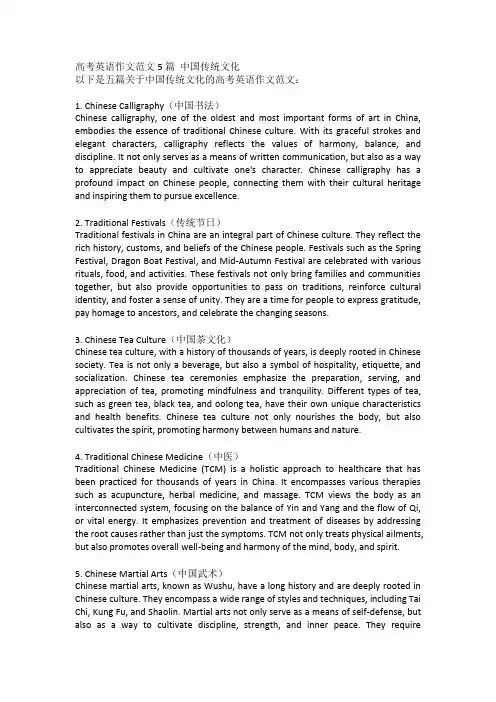
高考英语作文范文5篇中国传统文化以下是五篇关于中国传统文化的高考英语作文范文:1. Chinese Calligraphy(中国书法)Chinese calligraphy, one of the oldest and most important forms of art in China, embodies the essence of traditional Chinese culture. With its graceful strokes and elegant characters, calligraphy reflects the values of harmony, balance, and discipline. It not only serves as a means of written communication, but also as a way to appreciate beauty and cultivate one's character. Chinese calligraphy has a profound impact on Chinese people, connecting them with their cultural heritage and inspiring them to pursue excellence.2. Traditional Festivals(传统节日)Traditional festivals in China are an integral part of Chinese culture. They reflect the rich history, customs, and beliefs of the Chinese people. Festivals such as the Spring Festival, Dragon Boat Festival, and Mid-Autumn Festival are celebrated with various rituals, food, and activities. These festivals not only bring families and communities together, but also provide opportunities to pass on traditions, reinforce cultural identity, and foster a sense of unity. They are a time for people to express gratitude, pay homage to ancestors, and celebrate the changing seasons.3. Chinese Tea Culture(中国茶文化)Chinese tea culture, with a history of thousands of years, is deeply rooted in Chinese society. Tea is not only a beverage, but also a symbol of hospitality, etiquette, and socialization. Chinese tea ceremonies emphasize the preparation, serving, and appreciation of tea, promoting mindfulness and tranquility. Different types of tea, such as green tea, black tea, and oolong tea, have their own unique characteristics and health benefits. Chinese tea culture not only nourishes the body, but also cultivates the spirit, promoting harmony between humans and nature.4. Traditional Chinese Medicine(中医)Traditional Chinese Medicine (TCM) is a holistic approach to healthcare that has been practiced for thousands of years in China. It encompasses various therapies such as acupuncture, herbal medicine, and massage. TCM views the body as an interconnected system, focusing on the balance of Yin and Yang and the flow of Qi, or vital energy. It emphasizes prevention and treatment of diseases by addressing the root causes rather than just the symptoms. TCM not only treats physical ailments, but also promotes overall well-being and harmony of the mind, body, and spirit.5. Chinese Martial Arts(中国武术)Chinese martial arts, known as Wushu, have a long history and are deeply rooted in Chinese culture. They encompass a wide range of styles and techniques, including Tai Chi, Kung Fu, and Shaolin. Martial arts not only serve as a means of self-defense, but also as a way to cultivate discipline, strength, and inner peace. They requirededication, perseverance, and respect for both oneself and others. Chinese martial arts are not just physical exercises, but also a way of life that promotes self-improvement, self-discipline, and the pursuit of balance and harmony.希望以上范文能为您提供一些参考,祝您取得好成绩!。
高中英语高考英语作文有关中国传统文化的范文5篇带中文翻译以下是五篇有关中国传统文化的高考英语作文范文,附有中文翻译:范文一:Chinese Traditional Culture中国传统文化China has a rich and profound traditional culture that has been passed down for thousands of years. It encompasses various aspects such as philosophy, literature, art, and customs. Traditional Chinese culture plays a significant role in shaping the values and identity of the Chinese people.中国拥有丰富而深厚的传统文化,已传承了几千年。
它包含了哲学、文学、艺术和风俗等各个方面。
传统中国文化在塑造中国人民的价值观和身份认同方面起着重要作用。
One prominent element of Chinese traditional culture is Confucianism, which emphasizes moral values, filial piety, and social harmony. Confucian teachings have had a profound impact on Chinese society, influencing not only the way people behave but also the way they think and interact with others.中国传统文化的一个显著元素是儒家思想,强调道德价值观、孝顺和社会和谐。
儒家的教导对中国社会产生了深远影响,不仅影响人们的行为方式,还影响着他们的思维方式和与他人的互动。
中国传统文化名称英语翻译我们学了英语,需要用英文介绍中国的美食和文化时,是否常常困惑怎么准确地翻译中国传统文化名词?比如火锅、羊肉泡馍、小笼包、豆腐脑?比如《诗经》、《史记》、《红楼梦》、《西游记》?现在中国传统文化名词英语翻译来了,一起来学习起来吧!1、元宵节:Lantern Festival2、刺绣:Embroidery3、重阳节:Double-Ninth Festival4、清明节:Tomb sweeping day5、剪纸:Paper Cutting6、书法:Calligraphy7、对联:Couplet8、象形文字:Pictograms,/Pictographic Characters9、雄黄酒:Realgar wine10、四合院:Siheyuan,/Quadrangle11、战国:Narring States12、风水:Fengshui/Geomantic Omen13、昱曲:Kunqu Opera14、长城:The Great Wall15、集体舞:Group Dance16、黄土高原:Loess Plateau17、红白喜事:Neddings and Funerals18、中秋节:Mid-autumn Day19、花鼓戏:Flower Drum Song2O、儒家文化:Confucian Culture21、中国结:Chinese Knotting22、古装片:Costume Drama23、武打片:Chinese Swordplay Movie24、元宵:Tangyuan/Sweet Rice Dumpling25、越剧:Yue Opera26、火锅:Hot Pot27、江南:South Regions of the Yangtze River28、《诗经》:The Book of Songs29、谜语:Riddle3O、《史记》:Historical Records,/Records of theGrand Historian31、《红楼梦》:A Dream of Red Mansions32、《西游记》:The Journey to the West33、除夕:Chinese New Year’sEve/Eve of theSpring Festival34、针灸:Acupuncture35、唐三彩:Tri-color Pottery of Tang Dynas-ty/The Tang Tri-color Pottery36、二人车转:Errenzhuan37、偏旁:Radical38、孟子:Mencius39、亭/阁:Pavilion/Attic40、黄梅戏:Huangmei opera41、火药:Gunpowder42、农历:Lunar Calendar43、印/玺:Seal/Stamp44、腊八节:The laba Rice Porridge Festival45、京剧:Beijing Opera/Peking Opera46、秦腔:Qin Opera47、太极拳:Tai Chi48、《本草纲目》:Compendium of Materia Medica49、天坛:Temple of Heaven5O、小吃摊:Snack Bar/Snack Stand51、红双喜:Double Happiness52、文房四宝:The Four Treasures of the Study、笔墨纸砚:Brush,Inkstick,Paper,and Inkstone53、春卷:Spring Roll(s)54、莲藕:Lotus Root55、《三国演义》:The Romance of Three Kingdoms56、故宫博物院:The Palace Museum57、相声:Cross-talk/Comic Dialogue58、五行:Five Elements59、北京烤鸭:Beijing Roast Duck60、《桃花扇》:The Peach Blossom Fan61、木偶戏:Puppet Show62、敦煌莫高窟:Mogao Caves63、电视小品:TV Sketch/TV Skit64、甲骨文:Oracle Bone Inscriptions65、古筝:Chinese Zither66、二胡:Urheen67、门当户对:Perfect Match/Exact Match68、《水浒》:Water Margin,/Outlaws of the Marsh69、炸酱面:Noodles with Bean Paste7O、国子监:Imperial Academy71、兵马俑:Cotta Warriors,/Terracotta Army72、旗袍:Cheongsam73、指南针:Compass74、泼水节:Water-Splashing Day75、馄饨:Wonton76、花卷:Steamed twisted rolls77、羊肉泡馍:Pita Bread Soaked in Lamb Soup78、冰糖葫芦:A stick of sugar--coated haws79、八宝饭:Eight--treasure rice pudding80、粉丝:Chinese Vermicelli81、豆腐脑:Jellied bean curd82、小品:Witty Skits83、孝顺:To show filial obedience84、武术:NuShu(Chinese Martial Arts)85、宣纸:Rice Paper86、衙门:Yamen87、叩头:Kowtow88、中庸:The way of medium(cf.Golden Means)89、牌楼:Pailou(pai-loo)90、东坡肉:Dongpo Pork91、中山陵:The Sun Yat--sen Mausoleum92、秦淮河:Qinhuai River93、玄武湖:Xuanwu Lake94、夫子庙:The Confucian Temple95、甲鸭血粉丝:Chinese Vermicelli Cooked withDuck Blood96、盐水鸭:Yanshuiya,or boiled salted duck97、大煮千丝:Raised Shredded Chicken with Hamand Dried Tofu98、小笼包:Steamed buns99、明孝陵:Ming Tomb100、云锦:Nanjing brocade。
高中英语高考英语作文有关中国传统文化的范文5篇带中文翻译范文1:传统建筑Traditional Chinese architecture has a long history and outstanding artistic value. It reflects the cultural inheritance and spiritual characteristics of the Chinese nation, and is also an important component of the treasure trove of Chinese art.The characteristics of traditional architecture are emphasizing harmony, respecting nature, emphasizing meteorology, and reflecting national culture. Typical traditional buildings include various bridges on the Beijing Hangzhou Grand Canal, temples, gardens and different kinds of folk houses with different styles on both sides of the river. For example, the roof tiles, eaves, arch of wooden architecture and sculptures of ancient buildings have superb skills and exquisite aesthetic values. In traditional architecture, it also reflects the development of politics, economy, and culture. Nowadays, traditional architecture has not only become an important part of China's cultural soft power, but also an important role in Sino foreign exchanges, Chinese cities, and the tourism market. The value and significance of traditional architecture are receiving increasing attention and recognition.中国传统建筑,有着悠久的历史和卓越的艺术价值。
高中英语高考英语作文有关中国传统文化的范文5篇带中文翻译范文一:中国传统节日Chinese traditional festivals play an important role in Chinese culture. Among them, the Spring Festival is the most significant one. It is a time for family reunion, when people gather together, have festive meals, and exchange blessings. The Dragon Boat Festival and Mid-Autumn Festival are also celebrated widely. These festivals not only offer people a chance to relax and enjoy themselves, but also promote traditional values and customs, such as filial piety and respect for ancestors. Through these festivals, we can learn more about Chinese history, traditions, and customs, and pass them on to future generations.范文二:中国传统艺术Chinese traditional art, with a history of thousands of years, is a treasure of Chinese culture. Calligraphy, for example, is considered as the essence of Chinese culture. It not only requires skillful brushwork, but also embodies the beauty of Chinese characters. Chinese paintings, known for their unique painting techniques and rich cultural connotations, are admired by people all over the world. In addition, traditional Chinese music, opera, and dance are also highly appreciated for their elegance and grace. These art forms not only reflect the aesthetics of Chinese people, but also convey profound cultural meanings.范文三:中国传统美食Chinese traditional cuisine is renowned worldwide for its diversity and flavors. From the spicy Sichuan cuisine to the delicate Cantonese cuisine, each region has its own specialty dishes. For example, Peking duck, known for its crispy skin and tender meat, is a must-try when visiting Beijing. Dim sum, a variety of bite-sized dishes, is a popular choice for breakfast or afternoon tea in southern China. Chinese cuisine not only satisfies people's taste buds, but also reflects the philosophy of balance and harmony in Chinese culture. The art of Chinese cooking has been passed down from generation to generation, and it continues to evolve and innovate while preserving its traditional roots.范文四:中国传统服饰Traditional Chinese clothing, known as Hanfu, has a long history and unique charm. It is characterized by its loose, flowing silhouette and exquisite craftsmanship. Hanfu consists of various garments, such as the Ruqun for women and the Zhongshan suit for men. Each garment has its own distinctive style and symbolic meaning. Traditional Chinese clothing not only reflects the aesthetic taste of different dynasties, but also represents the etiquette and social status of the wearers. Nowadays, Hanfu is experiencing a revival, and more and more people are embracing it as a way to showcase their cultural identity and appreciation for Chinese traditions.范文五:中国传统建筑Chinese traditional architecture, with its distinctive style and profound cultural connotations, is a true representation of Chinese culture. The Forbidden City in Beijing, with its grandeur and meticulous design, is a masterpiece of traditional Chinese architecture. The classical gardens in Suzhou, known for their harmonious layout and exquisite details, showcase the perfect integration of nature and human creations. Traditional Chinese architecture also emphasizes the balance of Yin and Yang, and the harmony between man and nature. It is not only a manifestation of architectural skills, but also a reflection of the wisdom and philosophy of the Chinese people.范文一:中国传统节日中国传统节日在中国文化中占有重要地位。
关于中国文化,特别是传统文化中的一些热门元素,作为国人的我们,肯定是要比外国人要更清楚,掌握得更好一些。
从实际的角度来说,各种考试,比赛,辩论,写作,肯定是避不了了。
与其被动考试,不如主动出击:100个中国传统文化英文词汇,常见的节假日、中国美食、各种古典文学、名胜古迹等等100个中国传统文化英文词汇,转走学起~1.腊八节The Laba Rice Porridge Festival/Laba Festival2.除夕New Year s Eve3.春节The Spring Festival4.元膏节Lantern Festival5.清明节Qingming Festival/Tomb-Sweeping Day6.端午节Dragon Boat Festival7.七夕节Double Seventh Festival8.中秋节Mid-Autumn Festival9.重阳节Double Ninth Festival10.春联Spring Festival couplets11.拜年Paying a New Year call12.北京烤鸭Beijing roast duck13.豆藂Soybean milk14.馒头Mantou/steamed bun15.火锅Hot pot16.春卷Spring roll17.炸酱面Noodles with soybean paste18.麻花Fried dough twist19.粽子Zongzi/rice dumpling20.拉面Hand-pulled noodles/stretched noodles21.馄饨Wonton/chinese dumplingsoup22.豆腐Tofu/bean curd其它传统美食:年糕:Rice cake;New Year cake饺子:Dumplings;jiaozi汤圆:Dumplings made of sweet rice春卷:Spring roll八宝饭:Eight-treasure rice pudding (steamed glutinous rice with bean paste, lotus seeds, preserved fruit, etc.) 花生糖:Peanut candy瓜子:Red melon seeds红枣:Red dates冰糖葫芦:Candied haws on a stick腊肠:Chinese sausage腊肉:Preserved meat糖炒栗子:Sugar chestnut23.《史记》The Historical Records24.《诗经》The Book of Songs25.《春秋》The SSpring and Autumn Annals26.《论语》The Analects of Confucius27.《三国演义》Romance of the Three Kingdoms28.《术游传》Water Margin/Outlaws of the Marsh29.《西游记》Pilgrimage to the West/丁oumey to the West30.《红楼梦》A Dream in Red Mansions/The Story of the Stone31.《山海经》The Classic of Mountains and Rivers32.《三字经》Three-Character Scripture33.《资治通鉴》History as a Mirror34.长城The Great Wall35.泰始皇陵Mausoleum of the First Qin Emperor36.兵马偏Terra-Cotta Warriors37.敦煌莫高Mo Kao Grotto at Dunhuang38.敲楼Drum-tower39.故宫The Forbidden City/the Palace Museum40.天坛Temple of Heaven41.西湖West Lake42.日月潭Sun Moon Lake/Riyuetan Pool43.十三陵The Ming Tombs44.苏州园林Suzhou Garden(s)45.四大发明The four great inventionsof ancient China46.火药Gunpowder47.印刷术Printing/arts of printing48.造纸术Papermaking technology49.指南针Compass50.中国结Chinese knot51.青钥器Bronzeware52.瓷器china/porcelain53.刺绣Embroidery54.中药TCM/traditional chinese medicine55.四合院Courtyard56.京剧Peking opera57.皮影戏Shadow play58.太极Tai Chi59.对口相声Cross talk60.杂技Acrobatics/acrobatic performance61.中国武术Chinese martial arts/Kung Fu62.越剧Yue opera63.唐装Tang suit64.旗抱Cheongsam65.古筝Chinese zither66.二胡Erhu其它曲艺表演:戏曲:Traditional opera折子戏:Opera highlights相声:Comic dialogue;cross talk小品:Skits;sketch口技:Vocal imitations;ventriloquism 马戏:Circus performance京韵大鼓:Drum song of Peking踩高跷:Walk on stilts杂耍:Cariety show;vaudeville其它民间艺术:泥人:Clay figure木偶戏:Puppet show刺绣:Embroidery剪纸:Paper-cut中国结:Chinese knot年画:New Year painting吹糖人:Sugar-figure blowing舞龙:Dragon dance舞狮:Lion dance秧歌:Yongko dance;rural folk dance灯笼:Lantern67.甲骨文Oracle bone script68.世慈制度Hereditary system69.朝代Dynasty70.战国时期The Warring States Period71.三国The Three Kingdoms72.泰始皇The First Emperor of Qin73.皇太后Empress Dowager74.士大夫Scholar-officials/Literati and officialdom75.诸侯Vassal76.宰相Prime minister in feudal China77.西域The Western Regions各路神仙门神:The God of Door灶神:The God of Kitchen财神:The God of Wealth土地爷:The God of Land火神:The God of Fire喜神:The God of Happiness福禄寿三星:The three gods of fortune, prosperity and longevity八仙:The Eight Immortals78.武侠小说Martial arts novel79.八股文The eight-part essay/stereotyped writing80.五言绝句Five-character quatrains81.七言律诗Seven-character octave82.朦胧诗Misty poetry83.诗人Poet84.六艺The classic six arts85.民间艺术Folk art86.中国文学Chinese literature87.中国书法Chinese calligraphy88.古装片Costume flim89.国画Chinese painting90.儒学Confucianism91.孔子Confucius92.孟千Mencius93.法家Legalism94.墨家Mohism95.孝顺Filial96.中庸Doctrine of golden mean97.神话Mythology98.玉皇大帝The Jade Emperor99.美猴王Handsome Monkey King100.中千佳人Gifted scholars andbeautiful ladies 传统娱乐活动:打麻将:Play mahjong庙会:Temple fair春节联欢晚会:Spring Festival Gala Evening 灯会:Exhibit of lanterns送贺卡:Send New Year's greeting cards理发:Have a haircut放烟花:Set off fireworks放鞭炮:Set off firecrackers灯谜:Riddles written on lanterns。
高考英语:100个中国传统文化名词【2】51.红双喜:Double Happiness52.文房四宝(笔墨纸砚): The Four Treasure of the Study/Brush,Inkstick,Paper,and Inkstone53.春卷:Spring Roll(s)54.莲藕:Lotus Root55.罗盘:Luopan56.故宫博物院:The Palace Museum57.相声:Cross-talk/Comic Dialogue58.五行:Five Phases59.北京烤鸭 : Beijing Roast Duck60.《桃花扇》:The Peach Blossom Fan61.木偶戏:Puppet Show62.敦煌莫高窟:Mogao Caves63.电视小品:TV Sketch/TV Skit64.甲骨文:Oracle Bone Inscriptions65.古筝:Chinese Zither66.二胡:Urheen67.门当户对:Perfect Match/Exact Match68.《水浒》: Water Margin/Outlaws of the Marsh69.除夕:Chinese New Years Eve70.国子监:Imperial Academy71.兵马俑: Cotta Warriors/Terracotta Army72.旗袍:Cheongsam73.指南针:Compass74.泼水节:Water-Splashing Day75.馄饨:Wonton76. 花卷:Steamed Twisted Rolls77.羊肉泡馍:Pita Bread Soaked in Lamb Soup78.冰糖葫芦:A stick of sugar-coated haws (or apples,etc.)79.八宝饭:Eight-Treasure Rice Pudding80.粉丝:Glass Noodles81.豆腐脑:Jellied Bean Curd82.小品:Witty Skits83.孝顺:T o Show Filial Obedience84.武术:Wushu(Chinese Martial Arts)85.宣纸:Rice Paper86.衙门: Yamen87.叩头:Kowtow88. 中庸:The Way of Medium(cf. Golden Means)89.牌楼:Pailou(Pai-Loo)90.东坡肉:Dongpo Pork91.中山陵:The Sun Yat-sen Mausoleum92.秦淮河:Qinhuai River93.玄武湖:Xuanwu Lake94.夫子庙:the Confucian Temple95.鸭血粉丝:Duck Blood Fans96.盐水鸭:Yanshuiya, or Salted and Baked Duck97.大煮干丝:Gansi98.小笼包:Steamed Buns99.明孝陵:Ming T omb100.云锦:Nanjing brocade。